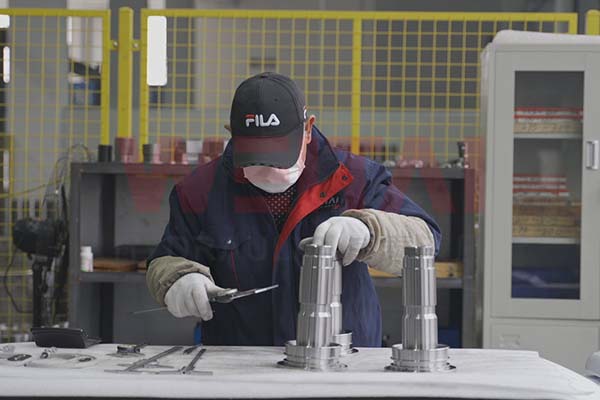In the ever-evolving realm of mechanical engineering and industrial automation, actuators are the unsung heroes that transform energy into purposeful motion, each type possessing unique qualities that make it suitable for specific applications. Let’s embark on a more in-depth comparative analysis of hydraulic gear rotary actuators and their counterparts.
Power Density
When it comes to power density, hydraulic gear rotary actuators truly stand out. Their ability to generate substantial torque is a result of the force exerted by pressurized hydraulic fluid on the gears. This enables them to handle heavy-duty tasks with ease. Consider the world of construction equipment, such as mammoth cranes and powerful excavators. These machines require actuators that can rotate heavy loads with authority. Hydraulic gear rotary actuators rise to the occasion, leveraging the incompressibility of hydraulic fluid to transmit force efficiently. In contrast, pneumatic actuators, which rely on compressed air, have a lower power density. Although air can move quickly, it doesn’t possess the same force-carrying capacity as hydraulic fluid. Pneumatic actuators are excellent for applications where high speed is a priority and the torque requirements are relatively modest, like in some light manufacturing processes that involve rapid, repetitive motions. Electric actuators, on the other hand, offer a different set of capabilities. They can achieve precise control through advanced electronics, but when it comes to raw torque output for heavy-duty applications, they may fall short compared to their hydraulic counterparts. For instance, in a large metal forging press that requires a significant amount of rotational force to shape the metal, hydraulic gear rotary actuators are the go-to option.
Accuracy and Precision
Electric actuators have long been lauded for their remarkable accuracy. With the help of sophisticated control algorithms and feedback mechanisms, they can be programmed to move to extremely specific positions with minimal deviation. This makes them the top choice in applications where micron-level precision is non-negotiable, such as semiconductor manufacturing. In this highly precise environment, even the slightest error can lead to defective chips. Hydraulic gear rotary actuators, too, can achieve a good level of precision, especially when equipped with modern control systems that can compensate for factors like fluid temperature and viscosity changes. However, these variables can pose challenges. As the temperature of the hydraulic fluid fluctuates, its viscosity changes, which can affect the actuator’s performance. Pneumatic actuators, due to the compressibility of air, are less accurate. The air’s ability to compress and expand means that the position of the actuator can be less consistent, making them a less favorable option for applications that demand high precision. But in many industrial settings where a balance between power and moderate precision is required, hydraulic actuators can offer a cost-effective solution. For example, in a machine tool that cuts metal parts, while not needing the extreme precision of a semiconductor process, still requires accurate and powerful rotational motion, and a hydraulic gear rotary actuator could be a suitable choice.

Response Time
Pneumatic actuators are renowned for their swift response times. The compressibility of air allows it to be rapidly compressed and expanded, resulting in quick actuator movement. Hydraulic gear rotary actuators also boast relatively fast response times, especially when the hydraulic system is engineered and maintained optimally. A well-designed hydraulic circuit with efficient valves and pumps can ensure that the actuator responds promptly to control signals. The response time of electric actuators can vary depending on the type of motor and control system employed. In some high-speed production lines, such as packaging or bottling plants, the decision between pneumatic and hydraulic actuators depends on multiple factors. If there is a reliable air supply and the application doesn’t require extremely high precision but demands rapid movement, pneumatic actuators might be a good fit. However, if power and a somewhat faster response time are crucial, hydraulic actuators could be the better option. For example, in a food packaging machine where containers need to be rotated and sealed quickly, the choice of actuator will impact the overall production speed and efficiency.
Cost Considerations
The initial cost of hydraulic gear rotary actuators can be relatively high. This is due to the complexity of the entire hydraulic system, which encompasses pumps, valves, hoses, and the actuator itself. These components need to be carefully selected and integrated to ensure proper operation. Additionally, maintenance costs can accumulate over time. Leaks in the hydraulic system can lead to fluid loss and potential damage to components, requiring costly repairs and fluid replacement. Electric actuators often have a lower initial cost, and their maintenance requirements are generally simpler. Routine checks of the motor and control system are typically sufficient to keep them running smoothly. Pneumatic actuators are relatively inexpensive to purchase and maintain. The main cost for pneumatic systems may be associated with the air compressor, depending on the size and capacity required. However, in applications where heavy-duty use is the norm and power and durability are of utmost importance over the long term, the total cost of ownership of hydraulic actuators may be justifiable. For instance, in an offshore oil rig where the actuators need to operate continuously in harsh conditions, the initial investment in a reliable hydraulic gear rotary actuator system may pay off in terms of performance and longevity.
In summary
The choice between hydraulic gear rotary actuators and other actuator types is a complex decision that hinges on a multitude of factors. Understanding the unique strengths and weaknesses of each actuator type is essential for engineers and operators to make an informed choice that optimizes the performance and efficiency of their systems. Whether it’s the brute force and reliability required in heavy industry or the precision and control demanded in high-tech manufacturing, the right actuator selection can make all the difference.
